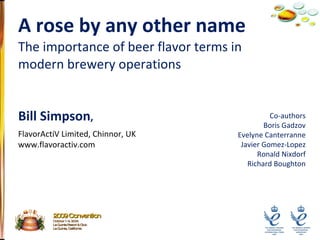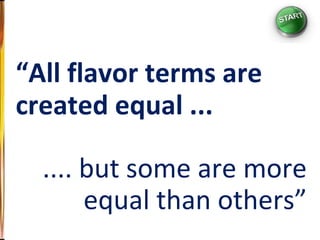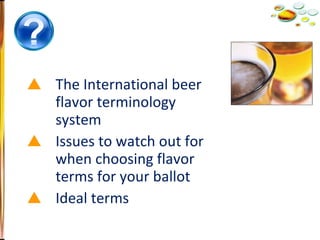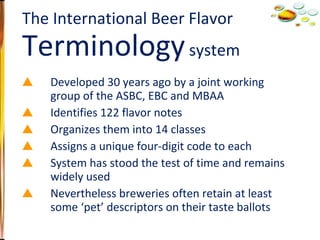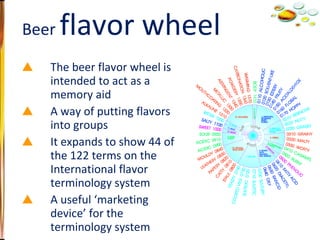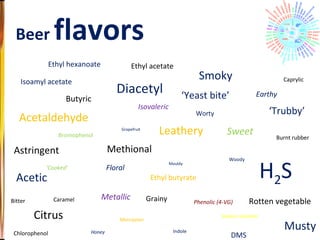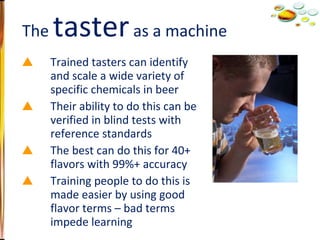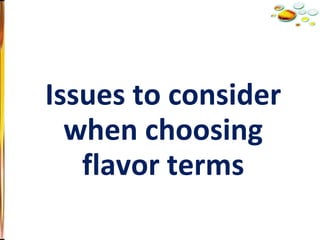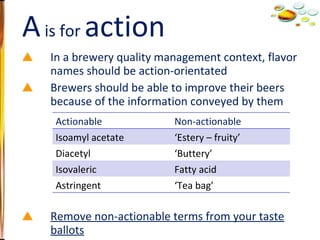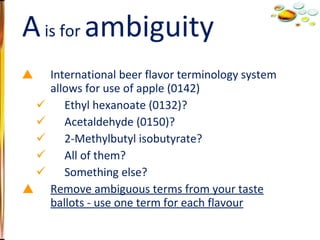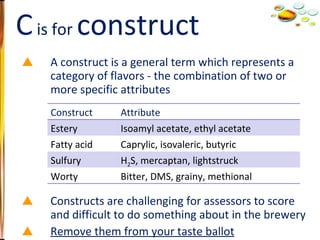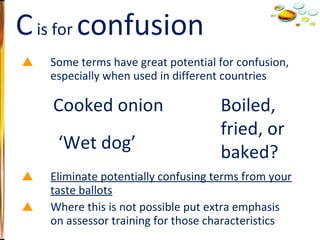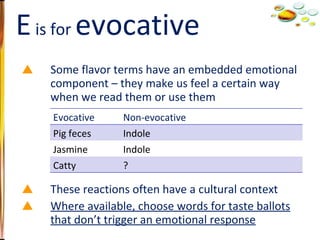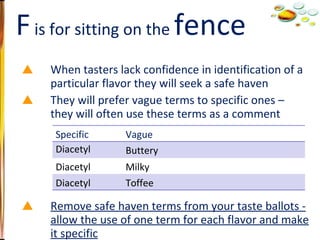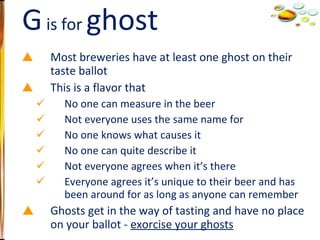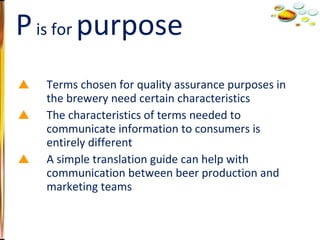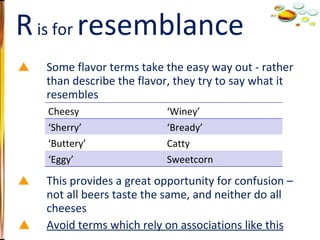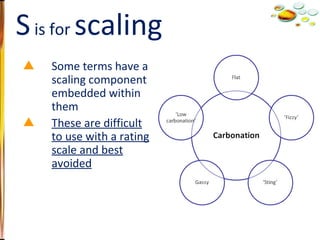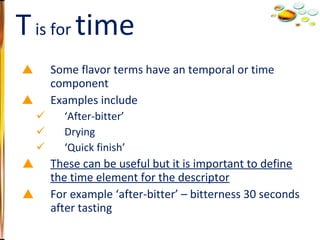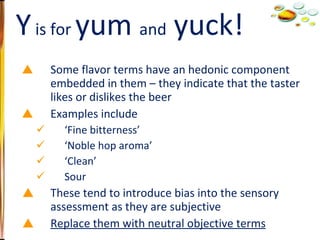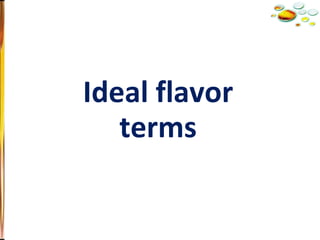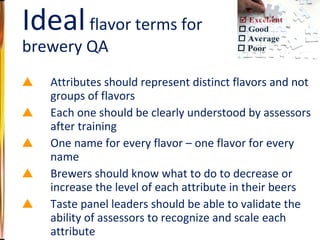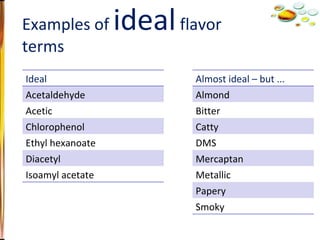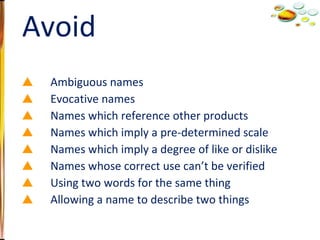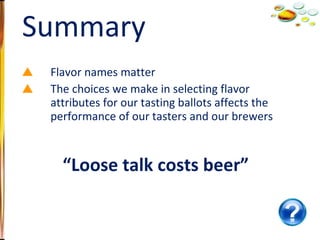A rose by any other name - the importance of beer flavor terms in modern brewery operations
- 1. Bill Simpson , A rose by any other name The importance of beer flavor terms in modern brewery operations FlavorActiV Limited, Chinnor, UK www.flavoractiv.com Co-authors Boris Gadzov Evelyne Canterranne Javier Gomez-Lopez Ronald Nixdorf Richard Boughton 2009 Convention October 1-4, 2009 La Quinta Resort & Club La Quinta, California
- 2. â All flavor terms are created equal ... .... but some are more equal than othersâ
- 3. The International beer flavor terminology system Issues to watch out for when choosing flavor terms for your ballot Ideal terms
- 4. Developed 30 years ago by a joint working group of the ASBC, EBC and MBAA Identifies 122 flavor notes Organizes them into 14 classes Assigns a unique four-digit code to each System has stood the test of time and remains widely used Nevertheless breweries often retain at least some âpetâ descriptors on their taste ballots The International Beer Flavor Terminology system
- 5. The beer flavor wheel is intended to act as a memory aid A way of putting flavors into groups It expands to show 44 of the 122 terms on the International flavor terminology system A useful âmarketing deviceâ for the terminology system Beer flavor wheel
- 6. Beer flavors Acetaldehyde Acetic Astringent Bitter Bromophenol Burnt rubber Butyric Caprylic Caramel Chlorophenol Citrus â Cookedâ Diacetyl DMS Earthy Ethyl acetate Ethyl butyrate Ethyl hexanoate Floral Grainy Grapefruit H 2 S Honey Indole Isoamyl acetate Isovaleric Leathery Malty Mercaptan Metallic Methional Mouldy â Yeast biteâ Worty Woody â Trubbyâ Sweet Solvent alcoholic Smoky Rotten vegetable Phenolic (4-VG) Musty
- 7. Trained tasters can identify and scale a wide variety of specific chemicals in beer Their ability to do this can be verified in blind tests with reference standards The best can do this for 40+ flavors with 99%+ accuracy Training people to do this is made easier by using good flavor terms â bad terms impede learning The taster as a machine
- 8. Issues to consider when choosing flavor terms
- 9. In a brewery quality management context, flavor names should be action-orientated Brewers should be able to improve their beers because of the information conveyed by them Remove non-actionable terms from your taste ballots A is for action Actionable Non-actionable Isoamyl acetate â Estery â fruityâ Diacetyl â Butteryâ Isovaleric Fatty acid Astringent â Tea bagâ
- 10. International beer flavor terminology system allows for use of apple (0142) Ethyl hexanoate (0132)? Acetaldehyde (0150)? 2-Methylbutyl isobutyrate? All of them? Something else? Remove ambiguous terms from your taste ballots - use one term for each flavour A is for ambiguity
- 11. A construct is a general term which represents a category of flavors - the combination of two or more specific attributes Constructs are challenging for assessors to score and difficult to do something about in the brewery Remove them from your taste ballot C is for construct Construct Attribute Estery Isoamyl acetate, ethyl acetate Fatty acid Caprylic, isovaleric, butyric Sulfury H 2 S, mercaptan, lightstruck Worty Bitter, DMS, grainy, methional
- 12. Some terms have great potential for confusion, especially when used in different countries Eliminate potentially confusing terms from your taste ballots Where this is not possible put extra emphasis on assessor training for those characteristics C is for confusion â Wet dogâ Boiled, fried, or baked? Cooked onion
- 13. Some flavor terms have an embedded emotional component â they make us feel a certain way when we read them or use them These reactions often have a cultural context Where available, choose words for taste ballots that donât trigger an emotional response E is for evocative Evocative Non-evocative Pig feces Indole Jasmine Indole Catty ?
- 14. When tasters lack confidence in identification of a particular flavor they will seek a safe haven They will prefer vague terms to specific ones â they will often use these terms as a comment Remove safe haven terms from your taste ballots - allow the use of one term for each flavor and make it specific Fence sitting F is for sitting on the fence Specific Vague Diacetyl Buttery Diacetyl Milky Diacetyl Toffee
- 15. Most breweries have at least one ghost on their taste ballot This is a flavor that No one can measure in the beer Not everyone uses the same name for No one knows what causes it No one can quite describe it Not everyone agrees when itâs there Everyone agrees itâs unique to their beer and has been around for as long as anyone can remember Ghosts get in the way of tasting and have no place on your ballot - exorcise your ghosts G is for ghost
- 16. Terms chosen for quality assurance purposes in the brewery need certain characteristics The characteristics of terms needed to communicate information to consumers is entirely different A simple translation guide can help with communication between beer production and marketing teams P is for purpose
- 17. Some flavor terms take the easy way out - rather than describe the flavor, they try to say what it resembles This provides a great opportunity for confusion â not all beers taste the same, and neither do all cheeses Avoid terms which rely on associations like this R is for resemblance Cheesy â Wineyâ â Sherryâ â Breadyâ â Butteryâ Catty â Eggyâ Sweetcorn
- 18. Some terms have a scaling component embedded within them These are difficult to use with a rating scale and best avoided S is for scaling
- 19. Some flavor terms have an temporal or time component Examples include â After-bitterâ Drying â Quick finishâ These can be useful but it is important to define the time element for the descriptor For example âafter-bitterâ â bitterness 30 seconds after tasting T is for time
- 20. Some flavor terms have an hedonic component embedded in them â they indicate that the taster likes or dislikes the beer Examples include â Fine bitternessâ â Noble hop aromaâ â Cleanâ Sour These tend to introduce bias into the sensory assessment as they are subjective Replace them with neutral objective terms Y is for yum and yuck!
- 22. Attributes should represent distinct flavors and not groups of flavors Each one should be clearly understood by assessors after training One name for every flavor â one flavor for every name Brewers should know what to do to decrease or increase the level of each attribute in their beers Taste panel leaders should be able to validate the ability of assessors to recognize and scale each attribute Ideal flavor terms for brewery QA
- 23. Examples of ideal flavor terms Ideal Acetaldehyde Acetic Chlorophenol Ethyl hexanoate Diacetyl Isoamyl acetate Almost ideal â but ... Almond Bitter Catty DMS Mercaptan Metallic Papery Smoky
- 24. Ambiguous names Evocative names Names which reference other products Names which imply a pre-determined scale Names which imply a degree of like or dislike Names whose correct use canât be verified Using two words for the same thing Allowing a name to describe two things Avoid
- 25. Flavor names matter The choices we make in selecting flavor attributes for our tasting ballots affects the performance of our tasters and our brewers â Loose talk costs beerâ Summary
- 26. Ėý
